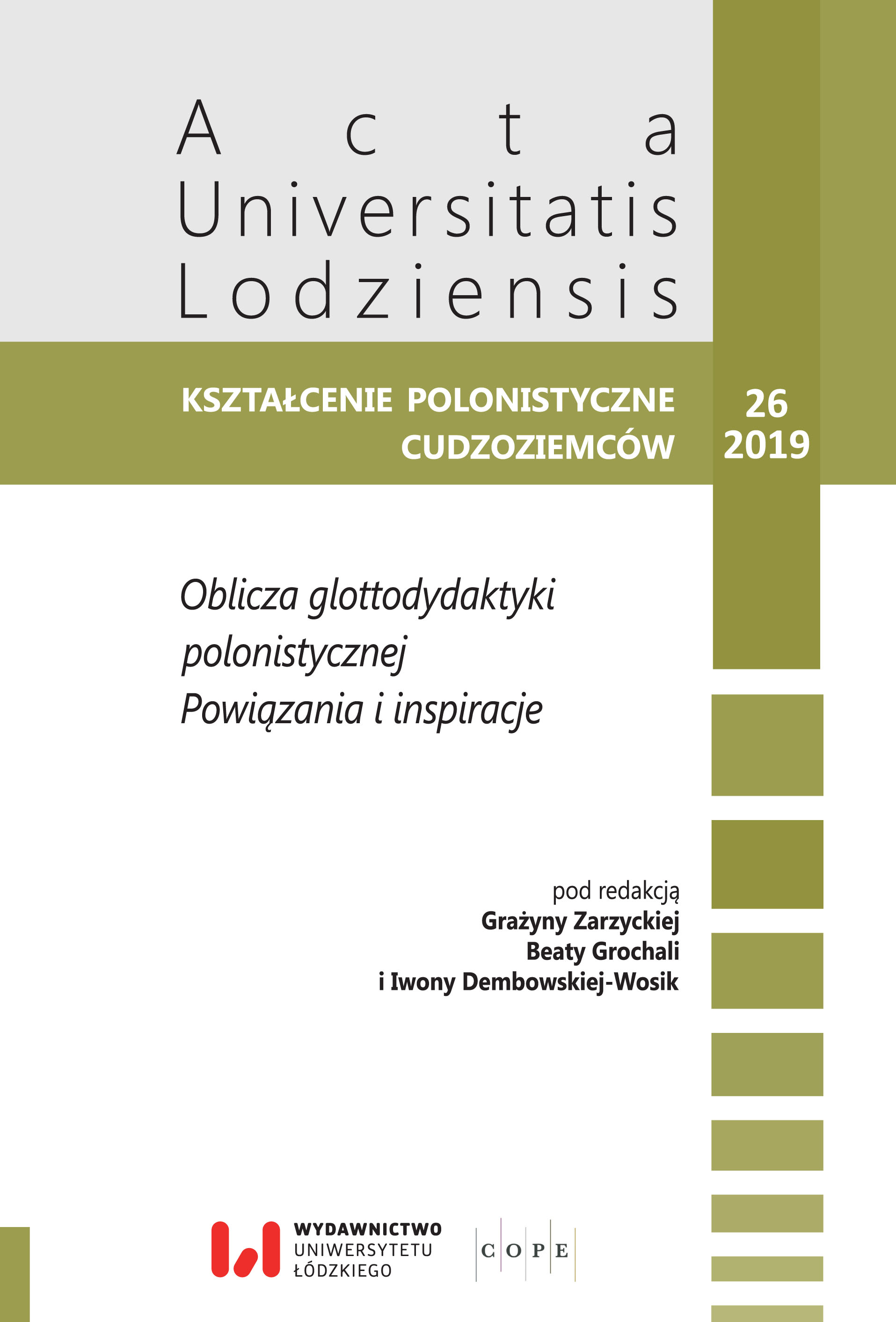The cover letter as a genre of speech in teaching Polish as a foreign language
DOI:
https://doi.org/10.18778/0860-6587.26.16Keywords:
genre studies, genre of speech, genre pattern, cover letter, teaching Polish as a foreign languageAbstract
Genres are products of cultures, reflecting the needs and practices of communities that have created them. Teaching the Polish language to foreigners, we should make them familiar with numerous Polish genres of speech, recommended in programmes of teaching Polish as a foreign language. The cover letter is a relatively new genre in the Polish continuum of speech, adopted from the Anglo-Saxon culture after the transition in 1989. It is a complex genre, deriving from others, such as the official letter, application, advertisement letter, and CV. The article presents a description of the genre, according to the genre pattern by Maria Wojtak, including four aspects: structural, pragmatic, ontological and linguistic. The dynamics of the genre resulted in the creation of a canon model, alternative variants and adaptive variants of this type of letter. The definition of the cover letter in terms of genre studies states that it is a short text (maximum one page) with a strictly defined structure, aiming at making the recipient (potential employer) hire the sender, it shows the sphere of life related to the world of labour and education, and is usually expressed in a schematic and clichéd manner (usage patterns are often copies of normative patterns). Foreigners should learn all four aspects of description of this genre of speech for effective communication in the environment of the Polish language and culture.
References
Bachtin M., 1986, Estetyka twórczości słownej, transl. D. Ulicka, Warszawa.
Google Scholar
Balbus S., 2000, Zagłada gatunków, in: W. Bolecki, I. Opacki (eds.), Genologia dzisiaj, Warszawa, pp. 156–171.
Google Scholar
Cieślak I., Cieślak L., 2005, Egzamin gimnazjalny. Jak to napisać, Toruń.
Google Scholar
Deming D. J., 2017, The growing importance of social skills in the labour market, http://scholar.harvard.edu/files/ddeming/files/deming_socialskills_aug16.pdf [7.04.2019].
Google Scholar
Gajda, S., 2001, Gatunkowe wzorce wypowiedzi, in: J. Bartmiński (ed.), Współczesny język polski, pp. 255–268.
Google Scholar
Grzesiak E., 1998, Schematy indywidualizować. Redagowanie pism użytkowych, “Polonistyka” 2, pp. 103–106.
Google Scholar
Janowska I., Lipińska E., Rabiej A., Seretny A., Turek P. (eds.), 2016, Programy nauczania języka polskiego jako obcego. Poziomy A1–C2, Kraków.
Google Scholar
Kałkowska A., 1982, Struktura składniowa listu, Wrocław.
Google Scholar
Kering A., Głogowski T., 2000, Curriculum vitae, czyli twój życiorys. Listy motywacyjne, Olkusz.
Google Scholar
Krauz M., 2001, Kompozycja listu motywacyjnego, „Tyczyńskie Zeszyty Naukowe”, no. 2, Tyczyn.
Google Scholar
Kurtuy A., 2019, How to write a motivation letter. Guide for beginners, https://novoresume.com/career-blog/how-to-write-a-motivation-letter [15.04.2019].
Google Scholar
Kuziak M., Rzepczyński S., 2012, Jak pisać?, Bielsko-Biała.
Google Scholar
Latham-Koenig C., Oxenden C., Lambert J., 2015, English File. Advanced Student’s Book, Oxford.
Google Scholar
Lipińska E., Dąmbska E., 2016, Pisać jak z nut, Kraków.
Google Scholar
Lurie S., 2013, The Cover Letter: A Short History of Every Job-Seeker’s Greatest Annoyance, https://www.theatlantic.com/business/archive/2013/09/the-cover-letter-a-shorthistory-of-every-jobseekers-greatest-annoyance/279564/ [15.04.2019].
Google Scholar
Madeja A., Morcinek B., 2007, Polski mniej obcy, Katowice.
Google Scholar
Malinowska E., 2001, Wypowiedzi administracyjne. Struktura i pragmatyka, Opole.
Google Scholar
Marcjanik M., 2001, Etykieta językowa, in: J. Bartmiński (ed.), Współczesny język polski, Wrocław, pp. 271–181.
Google Scholar
Ożóg K., 2001, Polszczyzna przełomu XX i XXI wieku. Wybrane zagadnienia, Rzeszów.
Google Scholar
Skwarczyńska S., 1937, Teoria listu, Lwów.
Google Scholar
Szydłowski B., 1999, Praktyczny poradnik poszukiwania pracy. Listy motywacyjne i curriculum vitae, Kraków.
Google Scholar
Tullis G., Trappe T., 2000, New Insights into Business, Harlow.
Google Scholar
Wojtak M., 1999, Wyznaczniki gatunku wypowiedzi na przykładzie tekstów modlitewnych, „Stylistyka, no. VIII, pp. 105–117.
Google Scholar
Wojtak M., 2004, Gatunki prasowe, Lublin
Google Scholar
Wolny M., 1998, List motywacyjny jako nowy gatunek językowy, „Poradnik Językowy”, vol. 4/5, pp. 1–11.
Google Scholar
Wolska K., 1967, Jak pisać listy i podania. Poradnik, Warszawa.
Google Scholar
Wolska K., Spirydowicz E., 1974, Listy, podania, pisma urzędowe, Warszawa.
Google Scholar
Zgółkowa H., 1994–2005, Praktyczny słownik współczesnej polszczyzny, Poznań
Google Scholar
Downloads
Published
How to Cite
Issue
Section
License

This work is licensed under a Creative Commons Attribution-NonCommercial-NoDerivatives 4.0 International License.










